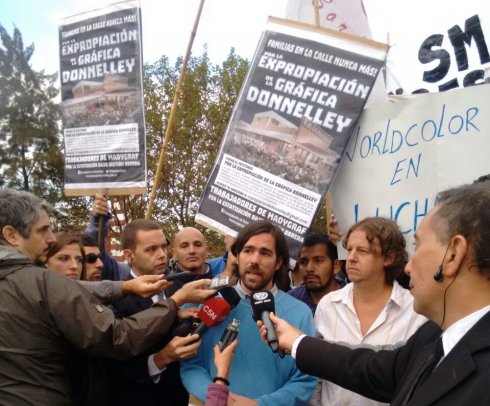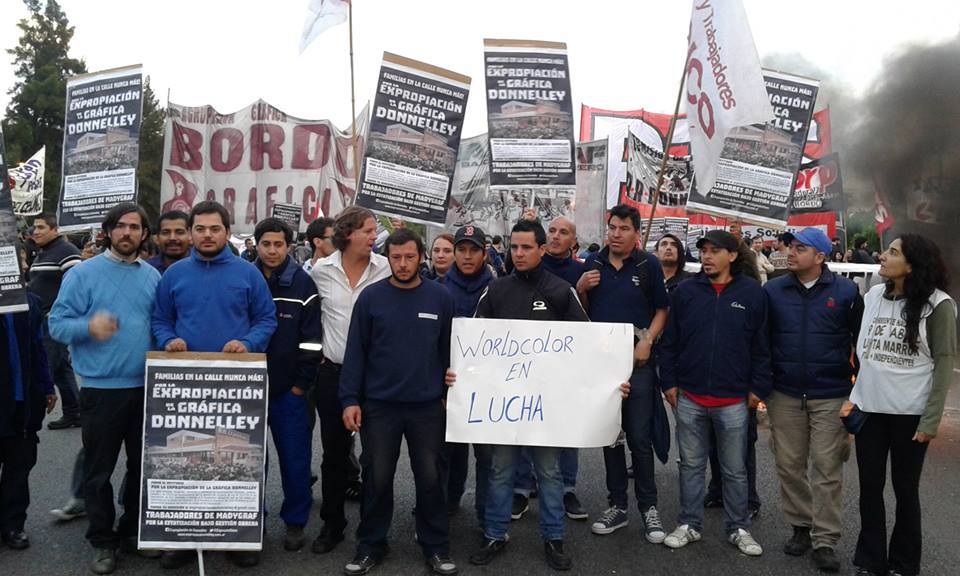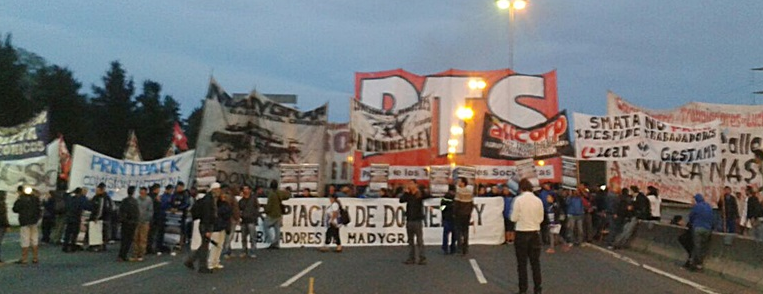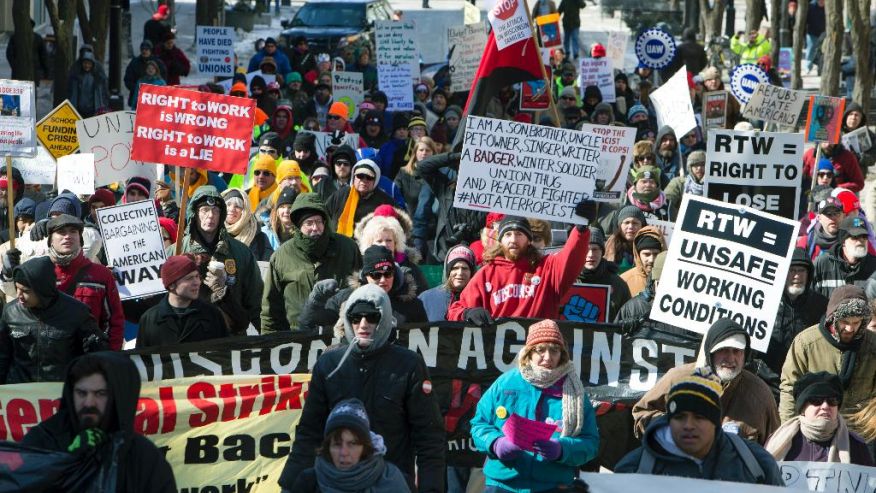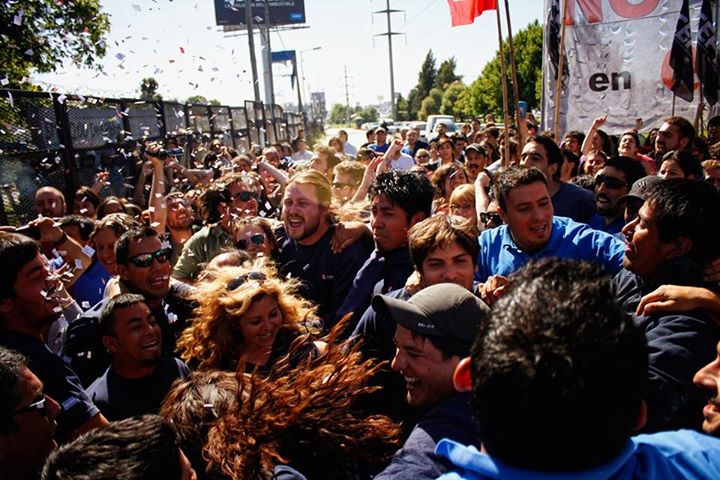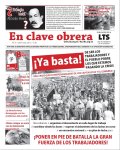Peru
Tremendous National Day of Protest
16/07/2007
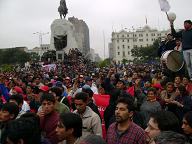
Repudiate the servile and repressive Alan García
Release the workers’ and people’s militants!
On Wednesday, July 11, the National Day of Protest, called by the
Confederación General de Trabajadores de Perú (CGTP), was carried out,
in defiance of the presence of the armed forces that President Alan
García sent to the main urban and production centers of the country. This national observance coincides with the teachers’ strike that has
been going on since July 5 against a draft education law in keeping
with the demands of the World (anti-spam-(anti-spam-(anti-spam-(anti-spam-Bank)))). Alan García enacted that law at
the last minute, bypassing parliamentary rules, with the support of
the pro-Fujimori legislators. Sending in the army, which has the
support of the businessmen’s associations, at a time when García’s
popularity is declining, shows the Bonapartist and reactionary course
the government is taking in the face of the wave of workers’ and
people’s demands. The campesino sectors, especially coca growers, and
the regions (provinces) joined the strike for their own demands in
open repudiation of the virtual state of siege decreed by the government.
Patience for García is disappearing in a large part of the population
after one year of Alan García and his party Alianza Popular
Revolucionaria Antiimperialista (APRA) in office and after promises of
changes in the Fujimori economic model. The latest surveys appear to
confirm this. According to CPI-Compañía Peruana de Opinión Pública,
for the month of May, García enjoyed only 40% approval of his
management. This tendency [for approval of García] to decline has been
expressed since the beginning of the year. The "encouraging" economic
figures, like 8% growth, a record surplus in foreign trade and in
international [currency] reserves cannot hide the fact that half the
population lives in extreme poverty in Peru.
Several campesino and coca-growers’ unions supported the National Day
of Protest. Construction workers’ unions, university teachers’ unions,
unions of support staff in the national universities, unions of city
workers, of sanitation workers, and students, among others, also
participated. The CGTP [union federation] drew up a petition which
demands a wage raise, suspending lay-offs, prison for Fujimori, and
repudiation of the Free Trade Agreement [with the US], among other points.
At the last minute, the Federación Minera joined the demonstrations,
but lifted its strike. According to the daily paper La República
(7/12/2007), "the President of the Federación Nacional de Trabajadores
Mineros, Luís Castillo, a participant in the march, explained that
they lifted the strike on July 10 and 11, because the demands of the
Casapalca miners had begun to be met."
The National Day of Protest was characterized by mobilizations and
confrontations. In Lima, the capital, thousands of demonstrators
condemned the government. The CGTP [union federation] organized a
massive demonstration; at the end of the demonstration confrontations
with the police broke out and left a toll of 16 demonstrators arrested
(La República 7/12/2007). In the Peruvian interior, demonstrators from
the SUTEP [teachers’] union and the CGTP marched together and
blockaded highways and bridges in Arequipa, Puno, Tacna, Ayacucho and
Cajamarca, among other regions.
In Puno, in southern Colombia, thousands of demonstrators seized the
local airport, hindering air traffic while they simultaneously
blockaded the main highways. According to Prensa Latina, in the Andean
center Tarma, the local police chief, Raúl Ortega, and one of his
cops, were wounded when they used tear gas to try to clear access
roads to the city, roads blockaded by demonstrators.
In the Junin area, a campesino died when a shopkeeper, trying to clear
a road, shot him. As the National Day of Protest ended, there was news
of the death of a teacher who had been beaten by cops on July 6 in a
demonstration in Lima.
The background of the National Day of Protest, July 11
For some months now, the government of Alan García has been
confronting a series of forceful measures by several workers’ and
people’s groups.
The mobilizations have typically spread through the length and breadth
of the country, and some lasted for a long time. They were also
characterized by militant methods, like blocking highways and
confrontations with the cops.
The Peruvian South is roaring
The demands by the regions are on the front line of the mobilizations.
In Peru, a centralized country, the budget is managed in an arbitrary
manner by the central government. Many of the most neglected regions
in southern Peru receive no assistance, since a big part of the budget
is devoted to paying the foreign debt. Thus, the regions of Moquegua,
Puno and Arequipa have declared a strike.
These demonstrations are run by Frentes Regionales that usually bring
together the "lively forces," that is, mayors, church groups,
intellectuals, shopkeepers; however, the workers and campesinos who
lead the blockades and confrontations with the forces of [bourgeois]
order, are expressing themselves. The regions aim at budget demands,
carrying out infrastructure construction, and repudiation of the Free
Trade Agreement, or any free trade bilateral agreement with the US
that would affect the regional economies, especially in the
countryside. In northern Peru, halfway through May and June, Ancash,
Loreto and Piura also made their demands felt.
The awakening of the miners and government repression
However, strikes by miners are the ones that have caused the García
government the most problems, and the miners’ strikes have received
repression and massacre as the only response.
On June 15, contract mine workers from Casapalca, located in the Lima
mountains, producing silver and lead, went on strike for two weeks,
demanding an end to contract hiring, when they were attacked by cops
during a protest, leaving four miners dead. The brutality of the
authorities and government is owing precisely to the fact that the
regime of contract hiring is what allows the transnational mining
corporations and local businessmen [to extract] super-profits, based
on the exploitation of the workers at a time of rising prices for the
minerals in the world market.
In the Ica region at the beginning of June, contract miners at the
Shougang Hierro Perú mine that were on strike for 58 days, sustained a
harsh blow, when the government and the Chinese firm that administers
the mine tried to behead the strike movement. To do that, they
arrested and imprisoned the miners’ main leader Rony Cueto, who
remains in prison.
Strikes in the three copper mines owned by Southern Copper, to demand
a contract, wages and improvements in health and educational services
were another milestone in the miners’ struggle in mid-June. One of the
characteristics is that the contract miners are not alone.
Environmental contamination, a result of zero planning by businessmen,
that have poisoned water and lands belonging to impoverished
campesinos, have unified the miners’ demand with campesino demands,
forging worker-campesino unity in those mining regions.
The teachers’ struggle
Almost since the moment that Alan García took office, rank and file
teachers have headed the opposition to the government. This is because
the government is trying to pass well-known laws from the World (anti-spam-(anti-spam-(anti-spam-(anti-spam-Bank))))
for education and trying to break the teachers’ union. The SUTEP
(teachers’ union, Sindicato Único de Trabajadores en la Educación del
Perú) has more than 300,000 members and is one of the biggest unions
in Peru. From the beginning of 2007, strikes and mobilizations by the
teachers have tried to oppose the government’s plan. Through a decree,
the state tried to make an evaluation to show flaws in training,
seeking to hold teachers responsible for the mistakes in the
educational system. The willingness of the teachers to fight sidelined
this attempt.
Now the government is going on the offensive again. Today the union
launched a general strike of indefinite duration against an education
law that leaves the door open to making the teachers’ work "flexible,"
and prohibiting strikes. The government has declared the strike
illegal and imprisoned several activists, as well as repressing
teachers’ demonstrations. And, in yet another proof of its reactionary
turn, the government put the law into effect, with the support of the
pro-Fujimori legislators, without waiting for a second debate in the
legislature, while thousands were marching through the streets.
As can be seen, the regional strikes, the miners’ strikes and the
struggle by the teachers give an account of the revival of the
Peruvian workers’ movement, after the long night under Fujimori and
the anti-worker government of Toledo. The regional struggles, and
those of miners and teachers are aimed against paying the foreign
debt, the Free Trade Agreement, "flexibility" at work and the World
(anti-spam-(anti-spam-(anti-spam-(anti-spam-Bank))))’s plans for education. The struggles are demanding a budget,
better working conditions and wages.
These demands can only be extracted by the workers as the result of a
big, unified struggle that puts the García government against the
ropes, since low wages, the lack of a budget and handing over natural
resources to transnational corporations are three of the pillars of
the economic work of Fujimori that Alan García is now administering
and is trying to deepen.
The leaderships of the workers’ and people’s movement
It is obvious that the call to the National Day of Protest, that the
CGTP finds itself forced to make, shows the aspiration of the
exploited masses for unity and their willingness to fight. This Day
must serve is a point of support for making an inventory of forces on
the road to preparing the political general strike to put the
government of Alan García up against the ropes.
However, the leadership of the SUTEP teachers’ union, influenced by
the Maoist group Patria Roja has been negotiating and conciliating the
governments on duty. Thus, it supported the candidacy of Toledo with
the excuse that an indigenous person would be governing the country
for the first time, and although afterwards he withdrew, it supported
the pre-candidacy of Alan García, seeking, as usual, a "progressive"
whom it could follow closely [1]. It does not propose to defeat the
draft education law, but to reach an agreement, to dialogue with, the
government. Faced with the enactment of the law by Alan García, on the
Day of Protest, the daily paper La República (7/12/2007) reports that
" ... yesterday SUTEP reached its seventh day on an indefinite strike by
marching through the streets and plazas of the country, demanding,
among other points, precisely that García should extend the debate on
the regulation before its publication."
For its part, the CGTP leadership, influenced by the old pro-Moscow
Communist Party, is trying to apply the force of the workers’ and
people’s mobilization to force García to keep his election promises
and for that it supports a front with the national business class
harmed by the "model" and progressive sectors of the Catholic Church [2].
The Federación Minera, while its leaders attended the central
demonstration in Lima, lifted the strike that it had called, thereby
weakening the National Day of Protest. The miners’ leaders mainly
committed a political crime: their strike cost 4 deaths and dozens of
arrests for struggling at a time when a reactionary and repressive
turn of the APRA government is underway.
The former nationalist presidential candidate Ollanta Humala deserves
a separate paragraph. The nationalist former soldier and his
legislators have dedicated themselves to making appearances in the
media, and, far from supporting the miners that are confronting the
voracity of the transnational corporations, Ollanta Humala limits
himself to waiting for the government to weaken, so he can appear as
an electoral opposition. Like every bourgeois nationalist leader, he
absolutely mistrusts the mobilization of the workers, the only ones
interested in defending the national interest against imperialism, as
shown by the democratic mobilizations against Fujimori before and the
days of struggle against Toledo afterwards.
Prepare the general strike
The servile and repressive government of Alan García is based on Bush,
the transnational mining corporations and the remaining Fujimori
supporters in the legislature. The government has granted the armed
forces the authority to intervene, together with the cops, for thirty
days to guarantee order throughout the country, that is, a virtual
state of siege (El Comercio 7/10/2007). This means that the government
will tend to acquire an increasingly Bonapartist and reactionary
character if it finds itself hounded by demands from workers and
campesinos. To confront the government consistently, it is necessary
to set up a national command entity for the struggle to prepare the
political general strike, and to take measures like self-defense of
the workers, faced with certain repression by the government,
guaranteeing worker-campesino unity and raising a program for a way
out of the situation of hunger and surrender, to which Fujimori,
Toledo, and, for the second time, APRA and Alan García have subjected
Peru. The struggle for the political independence of the Peruvian
working class and confidence in its own forces is an essential task,
so as to avoid falling into the traps that, sooner or later, the
nationalist opponents, the "lively forces" and the union bureaucracy
will have to contain and deflect the mobilization of the workers and
the poor of the city and countryside.
Translation by Yosef M.
NOTASADICIONALES
